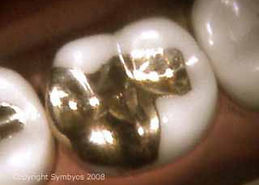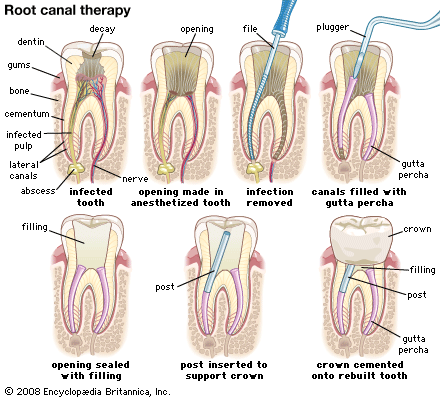DENTAL CARIES (TOOTH DECAY)

DENTAL CARIES ( Tooth Decay/Cavities) is an irreversible disease of calcified tissues of teeth, characterized by demineralization of inorganic portion and destruction of the organic substance of the tooth, which often leads to cavitation.
CAUSES : Tooth Decay is caused by bacteria that normally live in the mouth. The Bacteria cling to the teeth and form a sticky, colorless film called dental plaque. The bacteria in plaque live on sugars and produce decay causing acids that dissolve minerals on the tooth surfaces. Tooth decay can also develop on the exposed roots of the teeth if you have gum disease or receding gums(where gums pull away from the teeth, exposing the roots)
Carbohydrates(Sugars and Starches) increases the risk of tooth decay.Sticky foods are more harmful than nonsticky foods because they remain on the surface of the teeth. Frequent snacking increases the time that acids are in contact with the surface of the teeth.
SYMPTOMS: There may be no symptoms. If occurs they may include
1) Tooth pain or achy feeling , particularly after sweet, hot or cold foods and drinks.
2) Visible pits or holes in the teeth.
TREATMENT: Treatment can help prevent tooth damage from leading to cavities. Treatment may involve
a) Filling b) Root Canal Treatment c) Crown
Dentists fill teeth by removing the decayed tooth material. Filling material used are silver alloy, gold,porcelain, or composite resin. Porcelain and composite resin more closely match the natural tooth appearance and may be preferred for teeth.

Silver Filling


Gold Filling
A Root Canal Treatment is recommended if the nerve in the tooth dies from decay or injury. The centre of the tooth, including the nerve and blood vessel tissue (pulp) is removed along with the decayed portion of the tooth. The root canals are filled with the sealing material. The tooth is filled , and a crown maybe placed over the tooth.

Crowns or caps are used if tooth decay is extensive and there is limited tooth structure , which may cause weakened teeth. Large fillings and weak teeth increase the risk of the tooth breaking. The decayed or weakened area removed and repaired. A crown is fitted over the remainder of the tooth. Crowns are often made of metal, porcelain attached to metal, and porcelain.

Treatment often saves the tooth. Early treatment is not or less painful and less expensive than treatment of extensive decay.
PREVENTION : oral hygeine is necessary to prevent caries. This consists of regular professional cleaning or scaling (every 6 months), brushing at least twice a day and flossing at least a day.
Chewy, sticky foods (such as dried fruits or candy) are best if eaten as part of a meal rather than as a snack. If possible, brush the teeth or rinse the mouth with water after eating these foods. Minimize snacking which creates a constant supply of acid in mouth. Avoid constant sipping of sugary drinks or frequent sucking on candy abnd mints.
Dental sealents can prevent some cavities. Sealents are usually applied on teeth of children, shortly after the molars erupt. Older people may also benefit from the use of tooth sealents.

Topical Fluoride is also recommended to protect the surface of the teeth. This may include a fluoride toothpaste or mouthwash. Professional application of topical fluoride solution is also practised for the prevention of caries.
PERIODONTAL DISEASES & GINGIVAL DISEASES
What is Periodontal Disease ?
The word "periodontal" means "around the tooth". Periodontal Disease (also known as "gum disease","pyorrhea", or "periodontal infection") is an ongoing bacterial infection in the gums and bone around your teeth. This infection leads to an inflammation under the gums. If it isn't treated , the inflammation can destroy the bone around your teeth resulting in tooth loss. 75% of adult tooth loss is due to periodontal infection. More importantly, research is associated periodontal infection to several serious medical problems ; including heart disease, diabetes and stroke etc. Good oral health is a key component of a healthy body.
How does an "Ongoing Infection" work :
When you were a child, did you ever get a bad scrape that got all red and swollen ? That was caused by bacteria that got under your skin. The area then became infected and inflamed. It may have lasted for days or weeks, but eventually the inflammation went away. The inflammation disappeared when your immune system conquered the bacteria and the infection healed.
With an ONGOING infection , your immune system never wins the battle and infection keeps growing and the inflammation never goes away. Periodontal Disease is an ongoing infection in the pockets around your teeth. Your immune system is losing the battle and without treatment , it will get worse.
What can cause a "Burst" of infection Activity ?
People with periodontal disease have low resistance to periodontal bacteria.This causes an ongoing gum infection that grows in "bursts" of activity. Each time it grows, more support of your teeth is lost. Some factors that can cause a "burst" of activity are :
-
Poor Oral Hygeine
-
Dental Plaque
-
Smoking
-
Genetic factors
-
Stress or Tension
-
Diet
-
Age
-
Illness
Symptoms of periodontal Infection:
Periodontal Infection is usually painless until it reaches an advanced stage. However, there are some symptoms which can indicate the presence of periodontal infection.
These include :
-
Red or swollen gums
-
Bleeding when brushing (pink toothbrush), or at other times
-
Aching , itchy, sore or tender gums.
-
Receding gums (teeth begining to look longer)
-
Pus between your teeth and gums when you press down on the gums.
-
Bad breath
-
Any change in the way your teeth fit together when you bite.
-
Any change in the fit of partial dentures.
-
Loose, separating or protruding teeth
-
Spaces between teeth
If you notice any of the above warning signs of periodontal infections, please contact your Dentist.


IMPORTANT NOTE : Your gums can look and feel quite normal and deep pockets of periodontal infection can still be present. To be certain about any periodontal disease, ask your dentist to examine your gums for sign of infection.
TREATMENT :
The perodontal infection must be removed and the area given a chance to heal. There are generally two accepted treatments for this condition depending the severity of your infection.
-
UPPER LEVEL INFECTION REMOVAL : The upper level of infection in the pockets around your teeth can be removed using specialized instruments. This procedure is called "Scaling and Root Planing", "Phase One Treatment" or "Initial Therapy".
-
LOWER LEVEL INFECTION REMOVAL : If your infection is spread into the bone that supports your teeth and is below the level that can be reached in "Upper Level Infection Removal", then a surgical procedure must be performed to retract the gums and remove the lower infection.









